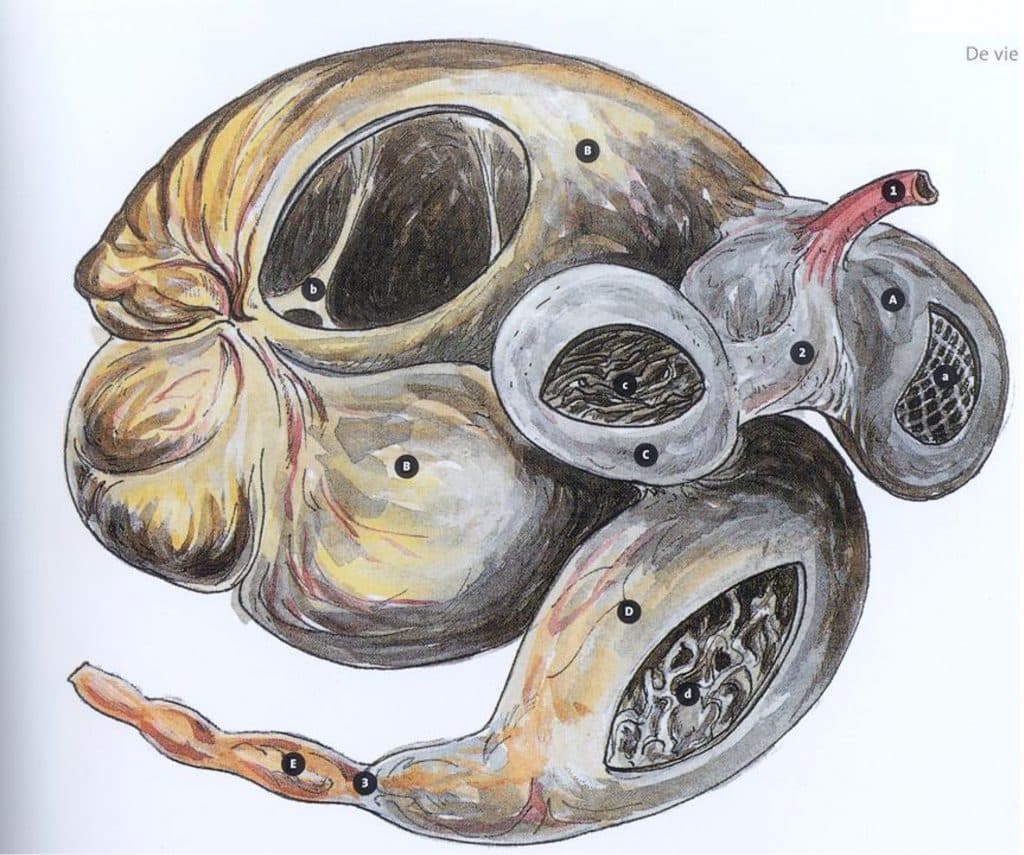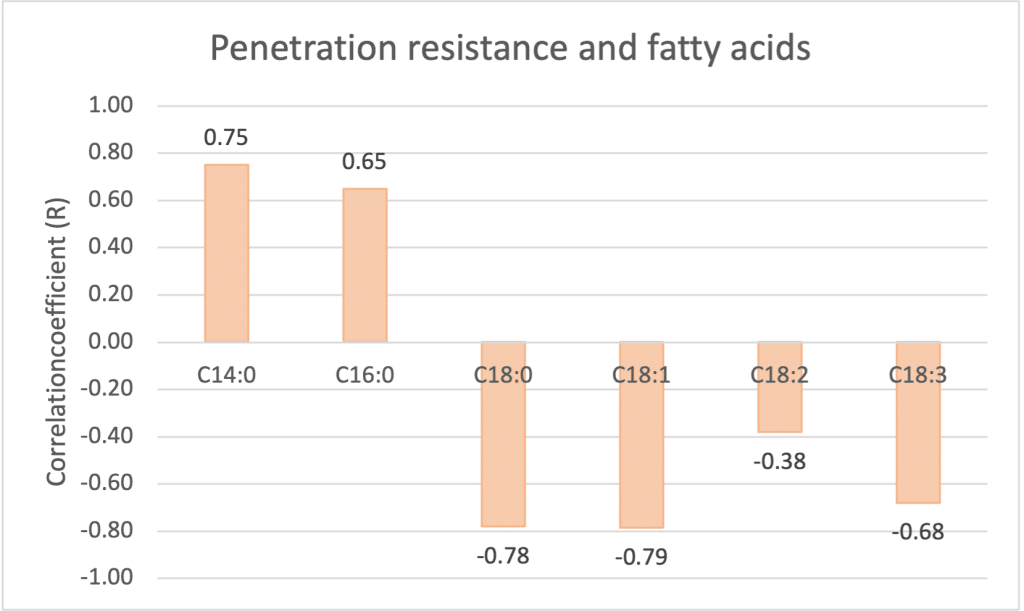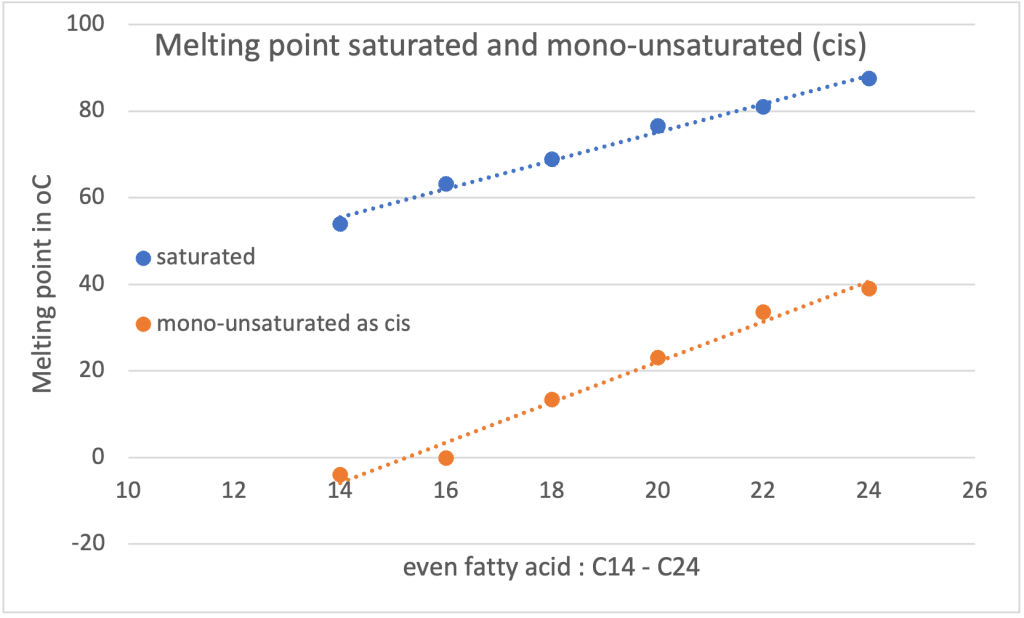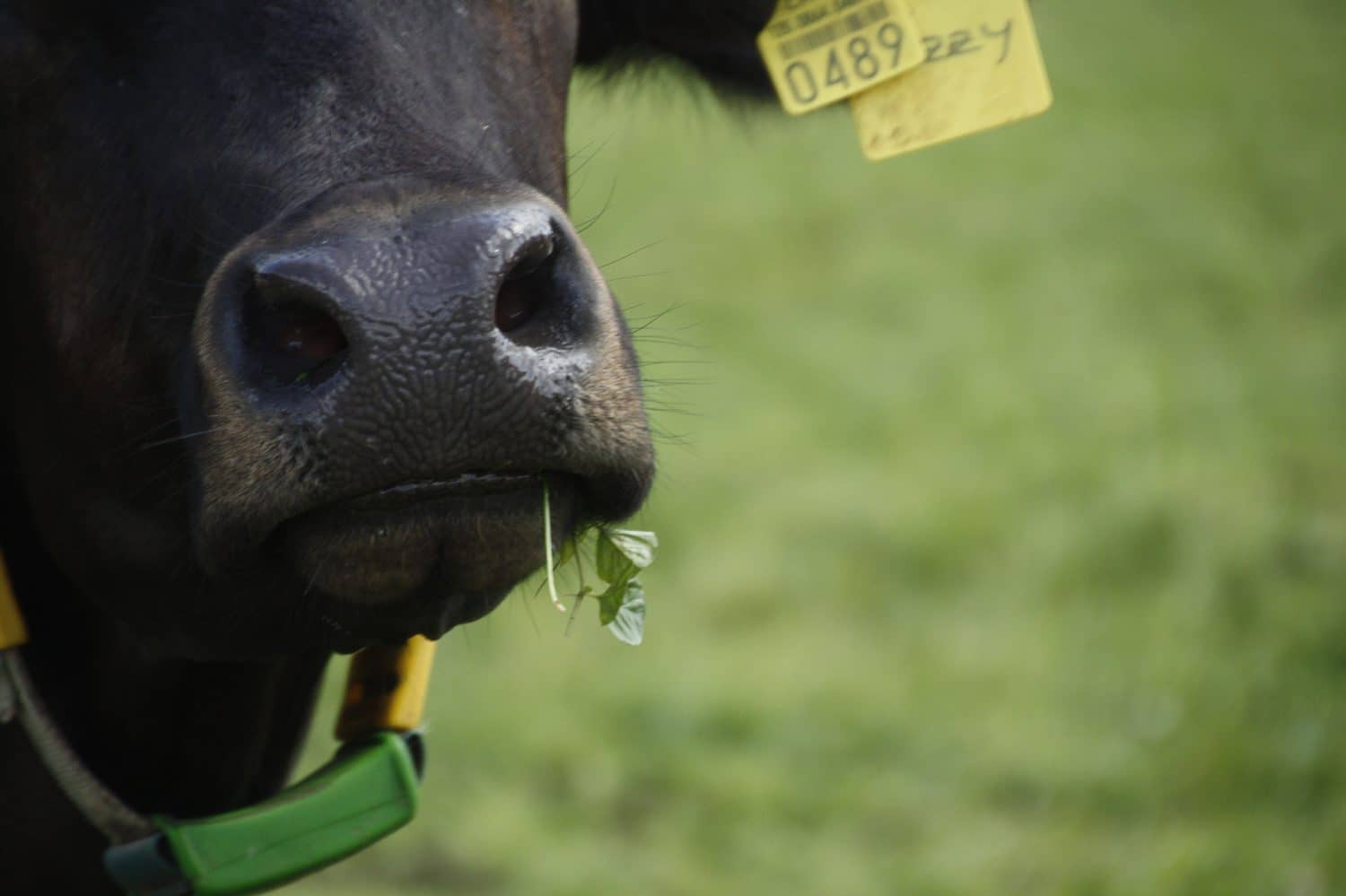Take home message
- A dairy cow is a ruminant and mammal. Her rumen is very important organ for processing fibers from roughage. Because the cow is ‘limited’ in digestion due to her size and humans always want more, dairy farmers feed cows as much concentrates as possible. Recently palm fat was added to the diet of cows to push milk fat production. However, this negavtively affected milk quality towards more saturated fat.
- To get more polyunsaturated fatty acids in milk fat cows should be grazed on fresh, growing grass or oils from linseed should be used.
What a cow wants?
A cow is a mammal and a ruminant. This makes her special, along with other ruminants. Like us, the cow has a digestive system with a stomach and intestines, however she is also a specialist to digest fibrous feed. Ruminants are equipped with a set of forestomachs: the rumen, abomasum, and book stomach. The rumen (B in Fig. 1) is a sack of more than 50 litres capacity. The cow’s rumen must be seen in relation to the rumination process: a grazing cow pulls in grass with her tongue, if you watch and listen, a cow slowly walks forward and you hear ‘rats, rats, rats….’. A cow has no upper teeth; the toothless upper plate along with the tongue tears off the grass. When there is a certain degree of satiety (‘full is full’), a cow usually lies down and starts the next step of digesting the grass: through ruminating. This goes into edible chunks, which are spit up from the rumen, a kind of controlled vomiting. If you look at this, you will see that the cow chews a chunk of feed about 50 times, grinding the grass fibres between her molars. The chewed-out chunk is swallowed again and ends up in the rumen. The rumen is a kind of collection vessel, a fermentation tank built up in layers. If you press a cow’s flank, you can feel the undulations of the rumen, which rhythmically mixes its contents. A cow does have time, she eats, lies down and starts the pre-digestion, as outlined above. Numerous micro-organisms live in the rumen, which grow on this decomposed grass, feed and concentrates. So, a new environment is created in the rumen, where bacterial protein is formed from rhoughage, which finally serves for digestion in the ‘real stomach’ and small intestine, similar like our own digestion.
The peculiarity of the cow (goat, sheep, camel, yak, …) is that they can thus eat food, which we as cannot eat, because we miss the forestoamchs (human, chicken, pig). When a dog or cat eats grass, they usually do so to evoke gagging, something must come out at the front. However, if your dog swallows grass further, it will come out undigested, just like with us. So, we can’t digest fibrous, stemmy plant products, a ruminant can.

Milk production rises
We started animal husbandry for our own benefit, we wanted meat, milk, leather. But also draft power and manure. Modern dairy cows have been bred for a single purpose only, either meat or lots of milk with high levels of fat and protein. In doing so, the cow was left with a problem – the size of her rumen. In a 50-litre rumen, only 50 litres fit. You can get more milk from bigger cows with a bigger rumen, but this too has its limits. As a first ‘solution’, we started feeding cows foods with less crude fibre and a higher energy density than grass, silage or hay. If you start feeding the cow like a chicken or pig, she will get more pellets or compound feed, like we also feed our dogs and cats. The English use the word ‘concentrates’, the Germans the word ‘mixed feed’ (Mischfutter) to indicate, that we feed (composite) products, with low crude fibre and high energy density, higher than that of grass products. The basis of ‘concentrates’ lies in cereals (oats, barley), legumes (soya, field peas, faba beans) on the one hand, and the use of waste streams from human nutrition on the other. Cows started producing more and more milk, but to further increase yield, vegetable oils were integrated. Fats have an even higher energy density than concentrate feed. Several fat and oil sources are possible for this, often as waste or residue from humane feed (sunflower oil, soybean oil, palm fat, rapeseed oil). Before we got fats and oil from a global market, more local sources were used: linseed, linseed cakes.
Several things can go wrong in cattle feeding if you start to feed a cow like a pig. The first problem was too much concentrate feed relative to roughage. Overacidification disturbs the rumen to such an extent that it comes to a standstill: the rhythmic undulation stops. The acidity level of the rumen goes up (pH down), because the cow does not get enough crude fibre from grass or hay to keep the rumen going. The second problem comes from the vegetable oils, cows got fed. Fat and oil have a very high energy density and provide a lot of energy for an organism in one go. However, the rumen must be able to handle it, which, however, with larger amounts of fat in the ration, leads to a film of fat in the rumen, and a cow not wanting to eat or eating less. You miss the mark, and the milk fat concentration in the milk declines.
So as attractive as it is to put a lot of grain and oil in a cow from a production point of view, the cow is not built for this. She thrives best on roughage.
Palm oil
There is some fuss around feeding palm. Palm oil contains a high proportion of palmitic acid (C16:0). When cows graze, they mainly absorb fat locked up in plant cells, the chlorophyll. In the large cow rumen, much of the mix of fatty acids (much alpha-linolenic acid, much linoleic acid as polyunsaturated fatty acids) is saturated, but also broken down into smaller fatty acids (especially acetylic acid and butyric acid, C2:0 and C4:0). After passage through the rumen, stomach and small intestine, these short-chain fatty acids are rebuilt in the udder to longer fatty acids. From C2:0, C4:0, through C6:0 …. to C14:0 and C16:0, the palmitic acid.
Palmitic acid appears to be the driver for the milk fat production and milk fat composition. There are two sources of the palmitic acid, namely from the endogenous metabolism, as outlined above, but there is also palm oil, which bypasses breakdown in the rumen, passes through the stomach and intestine and thus enters milk fat directly through the bloodstream. It turns out, when you feed cows ‘refined palm fat’, they get a boost in their milk fat production. For farmers, this can be financially attractive when they get more milk money based on higher fat and protein content in the milk.
Palm oil in butter and cheese
There is a disadvantage to having a lot of palm oil in the milk fat: overall the milk fat becomes more saturated and therefore butter is getting hard. This was traditionally the case after a winter diet, when cows ate hay and fodder beet when grass was no longer growing. A pale cheese or white butter that was stiff, firm and hard. In summer, cows ate (mainly) fresh grass, and the milk fat composition shifted towards monounsaturated fatty acids, especially oleic acid (C18:1cis9). Cheese from summer grass and grass butter is smooth and soft in consistency. Its colour yellow. The melting point of summer butter is a lot lower than that of winter butter due to the different ratio of saturated to unsaturated fat.
What is new is the phenomenon of feeding extra palmitic acid in the form of palm fat to cows. However, with the same result as the traditional change from summer to winter: butter and cheese with a firmer consistency due to a low proportion of unsaturated fatty acids.
In 2021, Polish researchers (Staniewski et al., 2021) published a nice study on the issue of ‘firmness of butter’, and ‘malleability of cheese’ in relation to the ‘composition of fatty acids’. Using a small device, the penetration resistance of butter was measured at different temperatures. It is the scientific approach to the question: how easily can I depress my packet of butter?

Figure 2 illustrates our experience at home: when you store butter at a higher ambient temperature (more to the right in the graph), it is softer, the penetration resistance becomes lower, and we can press the butter more easily. The impact of ambient temperature is applicable both to butter made in summer (blue) and winter (red), however, at the same temperature, summer butter is always softer than winter butter; the line is lower.
The resistance to penetration was compared the the fatty acid composition. To this end, the correlation (R) with single fatty acids was calculated (Fig. 3).

The resistance to penetration is higher (harder fat) when the concentration of C14:0 and C16:0 is higher. Both these fatty acids determine a large proportion of the saturated fat in milk fat. There is a converse correlation with C18:0 (stearic acid), oleic acid, linoleic acid and alpha-linolenic acid (softer fat). Large concentrations in milk fat are particularly oleic acid (C18:1c9). Figure 4 shows, how fatty acids (partly) determine the spreadability of butter (Knothe et al., 2009).

Milk fat is a blend of fatty acids, which the cow secretes in the fat globules as triglycerides. High contents and therefore strongly determining the melting point are palmitic acid (C16:0) and myristic acid (C14:0), together with oleic acid (C18:1c9).
Milk fat composition can be controlled by changing cows’ rations. When cows are fed a lot of starch from maize silage and concentrates, as well as traditional hay and fodder beet, the proportion of saturated fatty acids increases. In the last years, saturation increased using palm fat in the cow’s diet, especially refined palm fat, which consists almost exclusively of palmitic acid (C16:0). This palm fat bypasses the ‘normal breakdown and build-up in the rumen, stomach and small intestine and enters the milk fat directly. A good measure of the firmness of milk fat (butter, cheese included) is the ratio of palmitic plus myristic acid versus oleic acid (= sum of C16:0 + C14:0 divided by C18:1c9). However, this ratio still says nothing about the proportion of polyunsaturated fatty acids in the milk (LA n6 and ALA n3). When cows eat a lot of grass, the proportion of unsaturated fatty acid increases. Not only the monounsaturated fatty acids, but also the polyunsaturated fatty acids, such as alpha-linolenic acid (ALA n3) and CLA. With a grass ration, you combine a soft milk fat with a high proportion of polyunsaturated fatty acids. Linseed (flax) is also a source of extra ALA n3 in the ration and can somewhat compensate for the limitations of a winter ration (grass silage, maize silage, hay, beets, concentrates).
Literature
- Knothe, G., & Dunn, R. O. (2009). A comprehensive evaluation of the melting points of fatty acids and esters determined by differential scanning calorimetry. Journal of the American Oil Chemists’ Society, 86(9), 843-856.
- Staniewski, B., Ogrodowska, D., Staniewska, K., & Kowalik, J. (2021). The effect of triacylglycerol and fatty acid composition on the rheological properties of butter. International Dairy Journal, 114, 104913.
- Schad W. (1981). Säugetiere und Mensch. Verlag Freis Geistesleben, Stuttgart (D). In English as: Man and mammals; towards a biology of form. Waldorf Press.




